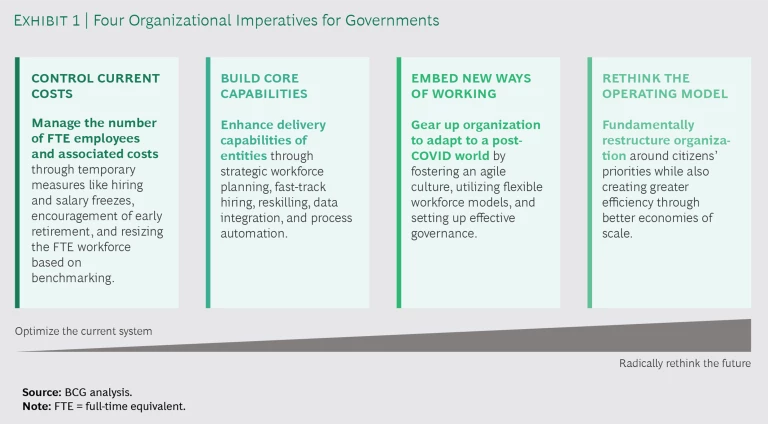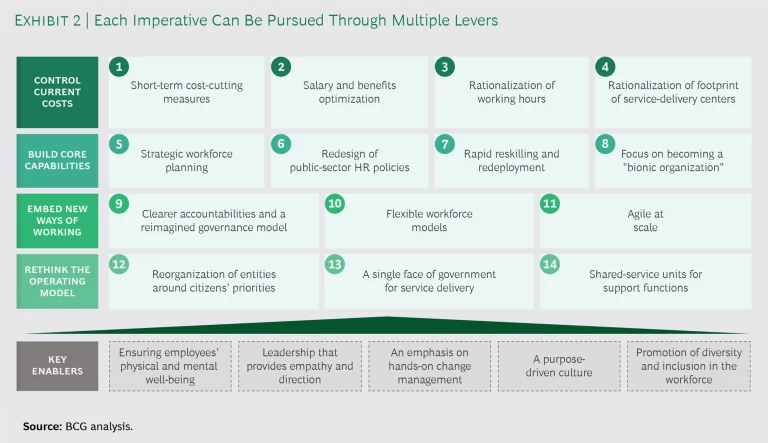Even before COVID-19 upended everything, governments faced a confluence of powerful forces . Rising expectations, ongoing rapid technological evolution, and accelerated globalization demanded an overhaul to the kinds of services governments at every level offered and the image they projected. The pandemic increased that urgency and added new pressures: public expectations of government intervention on multiple fronts, from preventive health care to fiscal stimulus and business stabilization. The resulting blow on budgets is forcing governments to do more with less. That, in turn, is yielding some positive developments after all the disruption: the crisis is giving governments unprecedented exposure to digital technologies, agile tools and approaches, and remote and flexible working models, all of which are easing the transition to new ways of working.
COVID-19 provides the right burning platform for governments to launch the necessary organizational rethinking and redesign.
COVID-19 provides the right burning platform for governments to launch the necessary organizational rethinking and redesign. We suggest they start by choosing from among a specific set of imperatives based on their particular needs and political environment.
Organizational Imperatives for Governments
We have identified four organizational imperatives for governments as they recast themselves to meet the immediate demands of COVID-19 and the evolving needs of tomorrow. These are as follows: control current costs in response to the sizable short-term cost pressures imposed by the virus; build core capabilities, including digital ones, to enhance the quality of policymaking and service delivery; embed new ways of working so that the entity is prepared for optimal functioning today and in a post-COVID-19 world; and rethink the operating model so that the organization can better deliver services to meet citizens’ changing priorities. (See Exhibit 1.)
Across these four imperatives for government entities, we have defined 14 possible levers for action, ranging from short-term to longer-term measures. (See Exhibit 2.) How a government chooses to prioritize among them will depend on its specific challenges and strategic needs, and on how feasible individual levers are to implement, given the prevailing political and regulatory climate.
Control Current Costs
Governments can rein in their current organizational costs in four different ways.
Cut costs short term. During similar crisis situations in the past, governments have taken any number of short-term cost-cutting measures, including those involving the public sector workforce (such as a targeted hiring freeze for noncore roles, early retirement acceleration, and sizing optimization of full-time-equivalent [FTE] employee positions). Should governments be inclined to consider such actions today, the viability, choice, and intensity of these measures will highly vary depending on the country, its economic and political context, and other relevant considerations.
During similar crisis situations in the past, governments have taken any number of short-term cost-cutting measures.
Optimize salary and benefits. Public sector salaries tend to rise over time due to periodic new allowances and adjustments for inflation. The result can be large numbers of inconsistent and/or outdated salary scales and allowances.
Governments can reduce such costs by reviewing salary scales and limiting increases in benefits or annual salary raises. For example, in 2018, the Ontario, Canada government instituted a temporary salary freeze for executives with annual salaries of Can$100,000 or more.
Rationalize working hours. In some countries, working hours of public sector employees are not on par with those of their private sector counterparts, with public sector employees working fewer weekly hours, having more days off per year, or both. By aligning their employees’ hours with those of the private sector, governments can improve employee productivity and thereby optimize FTE costs in the long run.
Rationalize the footprint of service-delivery centers. Many government entities have surplus numbers of branches, translating into unnecessary costs. To better leverage scale and reduce rent and maintenance costs, governments can seek to reduce the number and size of service-delivery centers by more closely aligning centers’ locations with demand (collecting data through geo-mapping) and by moving services online. This will not only reduce the overhead associated with a high number of branches but also improve the quality of services delivered.
Singapore faced a drop in its school-going population and the number of students entering junior college. This posed challenges in terms of providing an ongoing high-quality learning experience for all students. The government responded by merging schools and junior colleges; this ensured critical masses of students across the age range, which enabled ongoing provision of sufficiently rich, deep, and diversified curricula and activities.
Build Core Capabilities
Governments seeking to strengthen their service-delivery capabilities in the wake of COVID-19 might consider the following four levers.
Focus on strategic workforce planning. Government agencies often have limited insight into the capacity and skills that they will need in the future to deliver against their strategic priorities. Strategic workforce planning can help governments identify critical gaps in capabilities and skills that likely will emerge over the next five to ten years. This facilitates proactive planning for securing and maintaining specialized talent.
Strategic workforce planning can help governments identify critical gaps in capabilities and skills that likely will emerge over the next five to ten years.
Redesign public sector human resources policies. Many governments have a long list of rigid HR policies that create flaws in their systems. For example, jobs are often designed for lifetime employment, performance management is linked to tenure, and employees have limited opportunity to return to civil service once they have left it. In addition, there are often difficult hurdles for removing poor performers, and there are long lead times for filling job vacancies. To compensate for these flaws, the public sector often resorts to subcontracting, which typically involves higher costs. Instead, governments should address such problems directly by redesigning policies and processes that dictate hiring, managing, and promoting talent.
The office of Employment and Social Development Canada (ESDC) identified several challenges in its workforce—including a lack of diversity, high retirement rates, critical skills shortages, and the rapid approach of capacity limits in specific agencies—and sought to address them through changes in HR policies. It undertook a sizable overhaul of those policies, with the overarching aims of developing people with the right competencies, cultivating a diverse workforce, and building an environment that inspires employees to excel. The effort has been a success, with results such as a 25% increase in workforce diversity through increased hiring of indigenous people, and public recognition of ESDC as one of Canada’s best employers.
Set up rapid reskilling and redeployment mechanisms. Public entities are undertaking fundamental changes in their operating and delivery models. This requires new sets of skills across their workforces. To more effectively deploy their existing talent, increase their capabilities, and improve service delivery, governments can update skills profiles for specific roles and tasks, identify and launch critical reskilling and upskilling programs, and institutionalize an ongoing process to refresh people’s skills and redeploy them. Reskilling and redeploying the existing workforce is also often the best option in an environment where employees are hired for life or governments are competing for scarce talent.
Canada’s government launched its Free Agent Program, a cloud-based agency initiative that allowed employees to apply for roles in projects of their choice in order to staff civil servants in projects.
Canada’s government launched its Free Agent Program, a cloud-based agency initiative that allowed employees to apply for roles in projects of their choice in order to staff civil servants in projects. This led to the successful staffing of more than 40 projects across 20 agencies and an accelerated turnaround time to fill critical positions.
Focus on becoming a “bionic organization.” Governments are moving inexorably toward digitizing service delivery. This means that new capabilities and skills will be needed throughout the organization. To improve service delivery, employee productivity, and decision making, governments should focus on shifting repetitive tasks and simple decision making to machines, embedding data-driven business decisions in everyday work routines. In developing a roadmap for automation, governments need to take into account their strategic priorities and identify the human and digital resources that they will need to fulfill them.
For example, the Office of Justice programs at the US Department of Justice automated the procedure for reviewing grant applications, from an intuitive all-hands-on-deck process to a more objective, data-driven one. This resulted in significantly increased efficiency (the time needed for grant managers to capture grantee data decreased from 30 minutes to almost zero) and more frequent grant reviews (reviews can now be performed quarterly rather than annually).
Embed New Ways of Working
Three levers can help governments accomplish this.
Clarify accountabilities and reimagine the governance model. A common problem in government is that it is unclear who is responsible for what. This is especially the case when multiple entities need to collaborate to address an issue. To tackle this problem and, in the process, improve service delivery and decision-making, governments can define clear roles, responsibilities, and success metrics across all entities and levels of the organization. They can also rethink the governance model to facilitate faster decision-making.
Ireland’s government undertook an initiative (whodoeswhat.gov.ie) designed to clarify responsibilities and accountabilities so that the “who does what” questions are easy for the public to decipher.
Institute flexible workforce models. As governments adopt new ways of working, public sector entities need to incorporate flexible employment models to attract and retain a sufficiently skilled, more diverse workforce. For example, to increase agility and reduce overhead costs, governments can make greater use of freelancers and contingent-employment models. Likewise, virtual collaboration tools can facilitate remote working models across job functions.
Form agile-at-scale teams. Citizens are demanding faster responsiveness to their changing needs—and governments need to adapt. Agile can be a powerful aid in this effort. To implement change initiatives more quickly and improve collaboration across functions, governments can leverage agile methodologies to implement the initiatives and form agile teams outside the formal organization structure.
Rethink the Operating Model
Governments can fundamentally rethink their existing operating models to better suit citizen priorities in three different ways.
Reorganize entities around citizens’ priorities. Government bodies tend to proliferate, resulting in large numbers of entities, often with overlapping mandates. Best-practice governments review their setup regularly. To reduce operating expenses and improve service delivery, governments can identify entities or functions within them that could be merged or phased out because they no longer address citizens’ priorities or near-term needs, or because government is outsourcing a part of its services.
Australia’s government undertook a restructuring program designed to increase efficiency and effectiveness—with a target to reduce the number of government bodies by 20%.
Australia’s government undertook a restructuring program designed to increase efficiency and effectiveness—with a target to reduce the number of government bodies by 20%. It was thereby able to achieve significant savings on overhead costs while improving the quality of service delivery for citizens.
Present a single face of government for service delivery. The public sector typically delivers services to citizens using multiple entities. This results in numerous touch points and a complex user experience for citizens, as well as a larger-than-necessary footprint and higher costs for the government. To improve the quality and speed of delivery of services and reduce costs, governments can create customer-facing centers that consolidate service delivery across entities.
The Chilean government, for example, centralized most of its customer-facing activities under ChileAtiende, a single point of contact for public services through three channels: web portal, call center, or one of 250 offices. ChileAtiende now handles applications and delivery for pensions, certificates, grants, subsides, social programs, and scholarships.
Create shared-service units for support functions. In the public sector, support functions such as IT, finance, procurement, and HR tend to be replicated across entities, resulting in unrealized economies of scale and higher costs. To increase efficiency through greater leveraging of specialization, governments can consolidate support functions that serve multiple entities.
To increase efficiency through greater leveraging of specialization, governments can consolidate support functions that serve multiple entities.
To leverage shared services from support functions, for example, Singapore’s government created Vital, an entity combining HR and finance-processing activities. Vital now serves more than 100 government agencies.
Five Key Enablers of Transformation
In order for their transformation efforts to succeed, governments must start from a foundation that will facilitate success, including the following five enablers:
- Ensuring Employees’ Physical and Mental Well-Being. This is especially critical given the persistence of COVID-19. Governments can, for example, introduce new levels of hygienic measures across the organization and offer both practical and mental-health support to vulnerable groups of employees, such as parents with children at home who are attending school remotely.
- Leadership That Provides Empathy and Direction. Governments should define what “good” looks like among leaders by engaging and empowering high-performing individuals. They should also proactively address employees’ most pressing concerns and initiate two-way communication between leaders and employees to provide employees a voice in shaping the path forward.
- An Emphasis on Hands-On Change Management. For each change initiative a government undertakes, it should create a project-management office to lead, shape, and monitor the transformation and define success metrics and targets. Governments should also conduct periodic “pulse checks” to gather employee feedback on the change program.
- A Purpose-Driven Culture. Governments should translate learnings from the crisis into a desired culture and support demonstrated target behaviors. By articulating a clear goal of making a social impact, they can communicate why the change program matters for employees and all stakeholders, including citizens, vendors, and communities.
- Promotion of Diversity and Inclusion (D&I) in the Workforce. Governments should define a target distribution of socio-demographic profiles in line with their strategy and work toward it. They should also review talent-management policies to ensure equal opportunities for employees from all diverse backgrounds and hold inclusive events to drive broader engagement in the D&I effort.
How Should Governments Proceed?
A government keen to embark on this journey should begin, first, by identifying where it stands on all key capabilities across its organizations; the critical organizational challenges it faces; which challenges require particular focus in the wake of COVID-19; and which challenges will likely be most important in the future.
Second, it should determine which of the levers to focus on, depending on how feasible they are to implement and how valuable they are to the organization and its constituents. The strategic value to the government will hinge on a range of factors, including likely future national priorities, the potential cost savings in the long run, and the impact on service-delivery metrics. Implementation feasibility will depend on how rigid the civil-service laws are, the government’s digital readiness, how available funding is for the initial capital expenditures, and other variables.
Third, the government should design the specific levers it wants to employ. This will involve benchmarking and a detailing of the proposed solution and the operating model that will govern the new processes. It will also mean identifying other key enablers for success as well as assessing the likely impact and potential risks of the effort.
Finally, the government should test the feasibility of the levers it chooses to pursue with pilots and decide whether and how aggressively to scale those based on the results.
Today’s environment is obviously uniquely trying for governments. But they should view the circumstances as a springboard for action rather than an excuse to stay hunkered down. After all, governments have successfully carried out fundamental organizational reforms during times of crisis in the past.
Bold governments that seize the reins today—identifying the right set of levers and working on them in a targeted fashion—stand not only to see their constituents through the COVID-19 crisis. They also stand to emerge ideally positioned to tackle the needs of tomorrow—which will likely be extraordinarily demanding indeed.
















